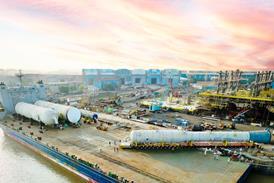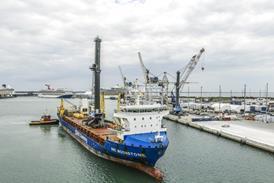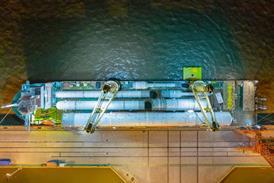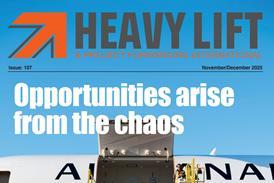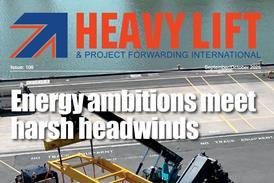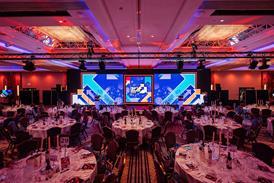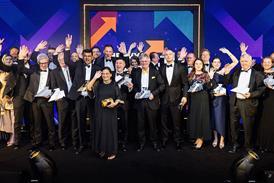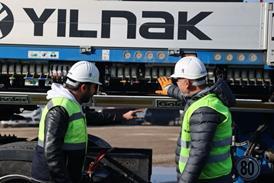Netherlands-based Mammoet has played a key role in the lifting and movement of next generation wind turbine components at Buss Terminal Eemshaven.
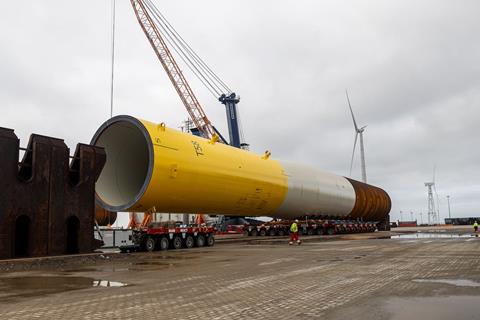
In 2023, Mammoet was selected by Buss Ports to marshal foundations for two of the largest offshore wind projects in Europe - Nordseecluster A (Germany) and Thor (Denmark). Both are joint offshore wind projects of RWE (51 percent) and Norges Bank Investment Management (49 percent). Mammoet’s scope was to manage the phased load-in, temporary storage and load-out of 116 XL monopile foundations for both wind farms at Buss Terminal Eemshaven in the Netherlands.
With different specifications of monopiles being shipped to the port in varying numbers, the load-ins had to be carefully planned so that marshalling equipment was configured in advance and space at the port could be managed effectively.
Adding further complexity was the limited ground bearing capacity of the quay, an unusual shipping configuration and the fast-changing tides – all of which required creative engineering to manage. The company said it was also instrumental in supporting Buss to reduce the total number of load-ins, saving on several 60-day global sea voyages.
Preliminary engineering work began in September 2023, with Mammoet carrying out a feasibility check using its XXL monopile transport system as a basis. Buss has developed its own saddle system for large monopiles and wanted to put it to work on this project with Mammoet’s SPMTs. Together, they ensured the saddle system was compatible with the SPMTs – chiefly, that its cylinders and hoses would connect to the transporter’s hydraulic system.
The monopiles for Nordseecluster A weighed around 1,500 tonnes and measured on average 85 m in length. The foundations for Thor were roughly 100 m in length and also weighed around 1,500 tonnes.
The XL monopiles were offloaded onto the quay using a ro-ro linkspan ramp and then transported using 80 axle lines of SPMT fitted with the Buss saddles. Monopiles are normally transported in a longitudinal configuration. However, to deliver more units per voyage they were loaded in a transverse orientation and protruded slightly over the side of the vessel.
To support this, Mammoet needed to unload these structures ‘sideways’. This methodology also allowed the load-out method from China to be reversed.
Due to the low ground bearing capacity of the quay, an unusually long linkspan ramp was used – the ramp stretched around 12 m before touching down on the quay.
Moreover, as the monopiles hung over the vessel’s edge, during load-out of the first foundation three axle lines of SPMT rested on the linkspan ramp rather than the deck.
Optimised approach
With the ramp around 400 mm higher than the deck of the vessel, the team would have had to use less packing on only these three axle lines, so that they could fit beneath the first monopile. This would have added considerable time to the load-ins, with the SPMTs and saddles needing to be reconfigured between the first and second monopile lift. It also would have meant that there would only be enough time to offload one monopile in the first tidal window. Therefore, an alternative solution had to be found.
Wouter Santen, project manager at Mammoet, explained: “To overcome this, we placed wooden mats on the deck of the vessel to gain the height we needed. This was done during a non-critical path outside of the tidal constraints. This approach avoided the need to reconfigure the SPMT between the first and second monopile lifts, allowing us enough time to offload two monopiles instead of one.”
To ensure the tidal constraints were comfortably met, the monopiles were offloaded with their sea grillages still attached, allowing the SPMTs to disembark quicker. Once the components were on the quayside, the grillages were removed using additional SPMTs. The monopiles were then driven to a temporary storage area and placed on sand bunds.
For the final load-outs, the monopiles were driven back to the quayside and lowered into concrete cradles, ready to be lifted onto the delivery vessel using its on-board crane.
By overcoming the tidal constraints and the limited ground-bearing capacity of the quay, It was possible for up to 10 monopiles to be delivered at a time instead of eight or nine, said Mammoet.

